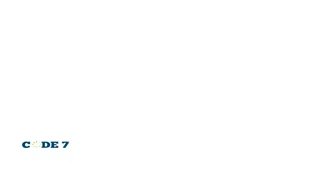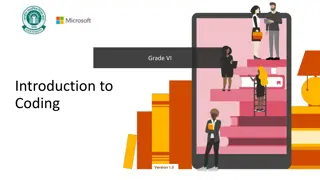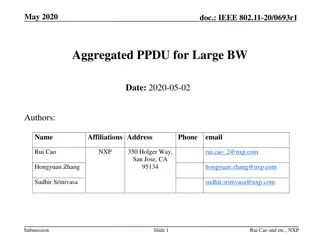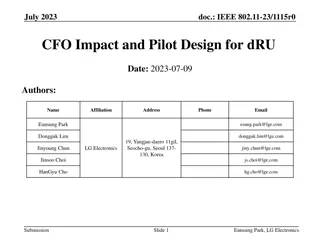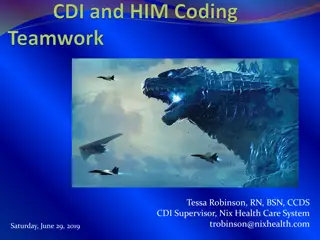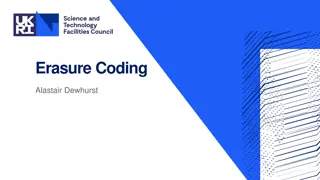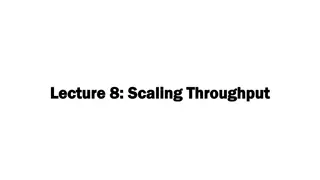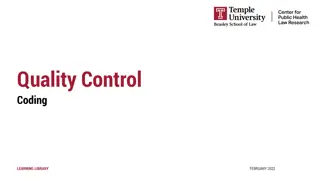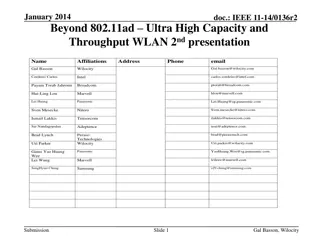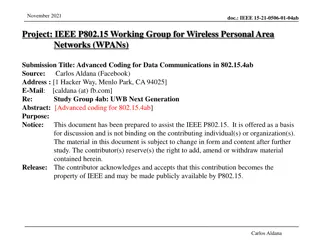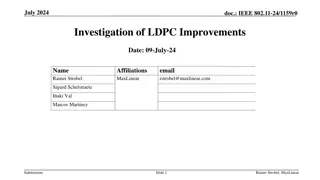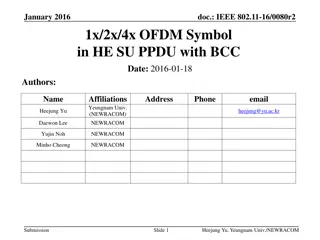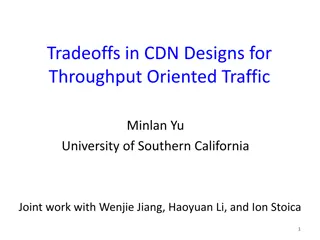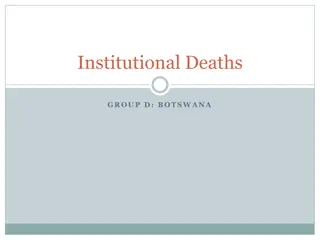LDPC Coding for 45GHz: Enhancing Throughput and Performance
Background information on LDPC coding in IEEE standards and the challenges faced in existing LDPC codes, particularly in terms of decoding throughput, complexity, and performance. The proposed solution introduces new base matrices with specific features to improve system efficiency and reliability, addressing issues such as waiting times, routing complexity, and signaling field coding limitations.
Download Presentation

Please find below an Image/Link to download the presentation.
The content on the website is provided AS IS for your information and personal use only. It may not be sold, licensed, or shared on other websites without obtaining consent from the author.If you encounter any issues during the download, it is possible that the publisher has removed the file from their server.
You are allowed to download the files provided on this website for personal or commercial use, subject to the condition that they are used lawfully. All files are the property of their respective owners.
The content on the website is provided AS IS for your information and personal use only. It may not be sold, licensed, or shared on other websites without obtaining consent from the author.
E N D
Presentation Transcript
September 2014 doc.: 11-14-0807-01-00aj LDPC Coding for 45GHz Date: 2014-09-09 Authors: Name Affiliations Address Phone Email Liguang Li ZTE Corporation Shenzhen China li.liguang9@zte.com.cn Jun Xu Zhifeng Yuan ZTE Corporation ZTE Corporation Shenzhen China Shenzhen China xu.jun@zte.com.cn yuan.zhifeng@zte.com.cn Sun Bo ZTE Corporation Sun.bo1@zte.com.cn Xi anChina Weimin Xing ZTE Corporation xing.weimin@zte.com.cn Xi anChina Kaibo Tian ZTE Corporation Tian,kaibo@zte.com.cn Xi anChina Shiwen HE Southeast University (SEU) Southeast University (SEU) Nanjing China hesw01@seu.edu.cn Haiming WANG Nanjing China hmwang@seu.edu.cn Submission Slide 1 ZTE Corp.
September 2014 doc.: 11-14-0807-01-00aj Background Structured LDPC codes have been adopted in several IEEE standards, which have the feature of good performance, low complexity, and high throughput. One parity check matrix H of size M*N is represented by one base matrix Hb of size mb*nb and one expand factor In 802.16e, 6 base matrices were applied to support 4 code rates and 19 code lengths (2005) In 802.11n/ac, 12 base matrices were applied to support 4 code rates and 3 code lengths 2009) In 802.11ad, 4 base matrices were applied to support 4 code rates and fixed code length 2012 Ultra high throughput requirement of 11aj (45 GHz) Maximum throughput of 10 G bps Submission Slide 2 ZTE Corp.
September 2014 doc.: 11-14-0807-01-00aj Background Layered decoder: R denotes that message is read in from memory, P denotes the processing of CNU(check node update unit), W denotes that message is written into memory. There is a waiting time between one row update and the next row update for one LDPC base matrix. Pipeline decoder[4][5]: The waiting time is reduced or eliminated Address conflict can be avoided Submission Slide 3 ZTE Corp.
September 2014 doc.: 11-14-0807-01-00aj Background The shortcomings of 802.11ad LDPC and other LDPC codes Limited decoding throughput due to a waiting time a waiting time between one row update and the next row update for one LDPC base matrix degrade the whole decoding throughput obviously. High routing complexity. Since base matrices for different code rates are random and independent, complex banyan networks are used for the routing operation. Cycle shift operation and inverse cycle shift operation make the routing complexity double Poor performance of signaling field coding in 802.11ad. Based on the code base matrix of rate , signaling field coding fails to fully obtain LDPC code gain. Not high girth More cyclic shift operation are needed for encoder the check part of base matrix is not a strictly low triangular matrix Submission Slide 4 ZTE Corp.
September 2014 doc.: 11-14-0807-01-00aj Proposed base matrices For all base matrices, the check part is a strictly low triangular matrix. All none -1 elements in the same column of different base matrices are from a set with 4 elements. For all base matrices, the girth of all systematic bit nodes 8, and the girth of all parity bit nodes 6 Features Most none -1 elements are even number The first none -1 element of each column is equal to zero. Submission Slide 5 ZTE Corp.
September 2014 doc.: 11-14-0807-01-00aj Proposed base matrix The code size n=672, and the four code rates are r0=1/2, r1=5/8, r2=3/4 and r3=13/16 respectively, the number of systematic bits corresponding to the four code rates are k0=336, k1=420, k2=504 and k3=546 respectively, and the expand factor z=42. r0=1/2 0 -1 -1 34 -1 12 -1 36 8 -1 0 -1 0 -1 0 -1 -1 16 40 -1 32 -1 22 -1 -1 20 -1 22 -1 2 -1 28 30 -1 18 -1 -1 14 -1 30 40 -1 12 -1 38 -1 6 -1 -1 24 -1 20 10 -1 2 -1 -1 0 -1 0 -1 0 -1 0 0 18 -1 -1 32 -1 -1 -1 -1 0 13 -1 -1 37 -1 -1 -1 -1 0 19 -1 -1 26 -1 -1 -1 -1 0 21 -1 -1 18 -1 -1 -1 -1 0 31 -1 -1 -1 -1 -1 -1 -1 0 13 -1 -1 -1 -1 -1 -1 -1 0 5 -1 -1 -1 -1 -1 -1 -1 0 r1=5/8 -1 0 8 30 -1 40 0 -1 0 40 18 -1 12 0 0 0 0 0 0 -1 0 -1 13 37 19 0 -1 0 21 -1 -1 -1 -1 -1 0 31 -1 -1 -1 -1 -1 0 13 -1 -1 -1 -1 -1 0 5 -1 -1 -1 -1 -1 0 -1 16 20 24 -1 -1 34 22 20 -1 32 -1 38 -1 10 -1 12 -1 2 14 22 -1 6 -1 2 -1 36 -1 28 30 18 32 -1 16 -1 19 -1 -1 -1 -1 Submission Slide 6 ZTE
September 2014 doc.: 11-14-0807-01-00aj Proposed base matrix r0=3/4 0 8 0 0 0 0 0 0 0 0 0 0 0 0 0 -1 0 -1 13 -1 -1 0 5 -1 -1 -1 0 16 20 24 40 18 12 34 22 20 32 38 10 12 2 14 22 6 2 36 28 30 18 32 16 13 37 19 19 26 34 -1 31 -1 30 40 21 18 r1=13/16 0 0 0 0 0 0 2 0 6 2 0 0 0 0 0 0 0 -1 0 5 -1 -1 0 30 40 20 24 18 12 22 20 38 10 28 30 32 16 37 19 26 34 21 18 34 8 -1 13 14 Submission Slide 7 ZTE Corp.
September 2014 doc.: 11-14-0807-01-00aj Performance of proposed base matrix Performance comparison on AWGN channel: N=672,NEW VS 11ad 0 10 R=1/2,11ad R=5/8,11ad R=3/4,11ad R=13/16,11ad R=1/2,NEW R=5/8,NEW R=3/4,NEW R=13/16,NEW -1 10 -2 10 BLER -3 10 -4 10 -5 10 1 2 3 4 5 6 7 SNRdB(Es/N0) Submission Slide 8 ZTE Corp.
September 2014 doc.: 11-14-0807-01-00aj Advantage of the proposed base matrix Base Matrix: Most of elements unequal to -1 are even. With the parallelism of 21, some clocks(t4-t3) reduction for every transition to next row. And speed up the decoding. Submission Slide 9 ZTE Corp.
September 2014 doc.: 11-14-0807-01-00aj Advantage of the proposed base matrix Base Matrix: Most of elements unequal to -1 are even. With the parallelism of 7, some clocks(t2-t1) reduction for every transition to next row. And speed up the decoding. Submission Slide 10 ZTE Corp.
September 2014 doc.: 11-14-0807-01-00aj Advantage of the proposed base matrix Throughput: Sf mb N Sf N Pipeline decoder: Mbps Mbps Layered decoder: + + (( ) ) 1 (( 1) ) zf p Iter t zf p t mb Iter Sf N Mbps Decoder of proposed base matrices: + + (( 1 ) ) zf p t x mb Iter x fs Operating frequency, N: size of LDPC code, zf expand factor, p decoder parallelism, mb number of base matrix s rows, Iter number of iteration, t clock number of RPW ,x clock number in advance. With code rate , p=21, iter=10, fs=500MHz, Throughput: t =3 clk t =4clk t =5 clk t =6 clk t =7 clk t =8 clk Pipeline decoder Layered decoder Layered decoder x=1 Layered decoder x=2 4.0976 G bps 4.0482 G bps 4.0000G bps 3.9529 G bps 3.9070G bps 3.8621 G bps decoding 2.1000G bps 1.6800 G bps 1.4000G bps 1.2000G bps 1.0500G bps 0.9333 G bps 2.7769G bps 2.0870 G bps 1.6716G bps 1.3942G bps 1.1957G bps 1.0467 G bps 4.0976G bps 2.7541 G bps 2.0741G bps 1.6634G bps 1.3884G bps 1.1915G bps Submission Slide 11 ZTE Corp.
September 2014 doc.: 11-14-0807-01-00aj Advantage of the proposed base matrix Base Matrix: All elements unequal to -1 in the same column of different base matrices are from the same set with 4 elements. Banyan network: Every column of base matrix need a banyan network for cyclic shift operation. Fixed network: 4 fixed network are provided for cyclic shift operation of every column of base matrix. Submission Slide 12 ZTE Corp.
September 2014 doc.: 11-14-0807-01-00aj Advantage of the proposed base matrix Base Matrix: All the elements unequal to -1 in the same column of different base matrixes are from a set with 4 elements. Complexity of network: with fixed network, proposed base matrices have simpler network(less modules of Either-or Operation). Proposed matrices: Fix network, Other issued matrices: Banyan network Complexity = number of levels number of Either- or Operation modules. Submission Slide 13 ZTE Corp.
September 2014 doc.: 11-14-0807-01-00aj Advantage of the proposed base matrix Base Matrix: The first element unequal to -1 every column is 0. Inverse cycle shift operation of every column can be avoided, needing half of cycle shift operation. Submission Slide 14 ZTE Corp.
September 2014 doc.: 11-14-0807-01-00aj Proposed LDPC base matrix Conclusion Most of elements unequal to -1 are even Decoding time reduction and high decoding speed. All the elements unequal to -1 in the same column of different base matrices are from a set with 4 elements Low complex fixed network instead of Banyan network The first element unequal to -1 of every column is 0. Inverse cycle shift operation can be avoided . The check parts of all base matrices are strictly low triangular matrices. Less cyclic shift operation for LDPC encoder Submission Slide 15 ZTE Corp.
September 2014 doc.: 11-14-0807-01-00aj Signaling field coding Why the signaling field coding need special designed The lowest code rate should be used for signaling field to maintain a robust reception The signaling bits is much less than the systematic bits of the one LDPC code word. Principle Compatible with the data field s LDPC code, Good performance. Signaling field SIG-A of 72 bits is encoded to 1024 bits, and SIG-B of 40 bits is encoded to 672 bits. Submission Slide 16 ZTE Corp.
September 2014 doc.: 11-14-0807-01-00aj Proposed Signaling field Coding Encoding the signaling field with 72 bits(SIG-A) The signaling bits of SIG-A can be shown as . The length of and are 30 and 42 respectively. The signaling bits repeat once and is encoded to generate the parity sequence with length of 336 bits by using rate 1/2 LDPC code with the element of base matrix . The mother codeword is . And the sequence of first 1024 bits of three copies of is LDPC code output. The location of , and in the base matrix show as: b 1x = x x x 0 x [ , ] 0 1 b = 1 hb 2 6 = c [ , ] x b c 0 x 1 x Submission Slide 17 ZTE Corp.
September 2014 doc.: 11-14-0807-01-00aj Proposed Signaling field Coding Encoding the Signaling field with 40 bits(SIG-B) The signaling bits of SIG-B can be shown as . The signaling bits repeat once and is encoded to generate the parity sequence with length of 336 bits by using rate 1/2 LDPC code base matrix . The mother codeword is . And the sequence of first 672 bits of three copies of is LDPC code output. The location of and in the base matrix show as: x b x b c = c [ , ] x b Submission Slide 18 ZTE Corp.
September 2014 doc.: 11-14-0807-01-00aj Signaling field coding Signaling-Field Code, 64-672 Performance(AWGN) Simulation condition: 64 bits input, 672 bits output, AWGN, QPSK 0 10 NEW 11ad -1 10 BLER 0.8dB -2 10 NEW: Proposed coding scheme -3 10 11ad: Scheme issued in 802.11ad -4 10 -7 -6 -5 SNRdB(Es/N0) -4 -3 -2 Submission Slide 19 ZTE Corp.
September 2014 doc.: 11-14-0807-01-00aj Proposed LDPC base matrix Comparison Good Good Data field coding Performance Poor Poor Both have the same performance Proposed LDPC LDPC of 11ad Signaling coding performance Simplicity Proposed LDPC is less than about 40% of 11ad. Coding gain 0.8dB for BLER=0.01 Throughput More than about 150% times Submission Slide 20 ZTE Corp.
September 2014 doc.: 11-14-0807-01-00aj Conclusion We proposed a new LDPC base matrix for group discussion We also design the signaling field coding procedure using the proposed LDPC base matrix . Submission Slide 21 ZTE Corp.
September 2014 doc.: 11-14-0807-01-00aj References [1]. IEEE Std 802.11ad [2]. 11-14-0716-02-00aj-phy-sig-frame-structure-for-ieee-802-11aj-45ghz [3]. Rate=5/6 LDPC Coding for OFDMA PHY , C80216e-05_066r2 Robert Xu, etc [4]. Min-seok Oh, Kyuhyuk Chung ,etc. IEEE C802.16e-06/168 -Informative: LDPC parallel processing in IEEE802.16e . [5]. Brian Classon, Yufei Blankenship. IEEE C802.16e-05/066r3- LDPC coding for OFDMA PHY . [6]. High Girth LDPC Coding for OFDMA PHY , IEEE C80216e-05_126r1 Robert Xu, Mansour, M.M.; Shanbhag N.R. [7]. "A 640-Mb/s 2048-Bit Programmable LDPC Decoder Chip", IEEE Journal of Solid- State Circuits, vol. 41, no. 3, pp. 684-698, Mar. 2006 [8]. T. Zhang and K. K. Parhi, "Joint (3,k)-Regular LDPC Code and Decoder/Encoder Design", IEEE Transactions on Signal Processing vol. 52, no. 4, pp. 1065-1079, April, 2004 Submission Slide 22 ZTE Corp.
September 2014 doc.: 11-14-0807-01-00aj Straw Poll Do you support to add to the 11aj spec the LDPC basic check matrixes for 45GHz operation as proposed in slide6-7? Y/N/A Submission Slide 23 ZTE Corp.



